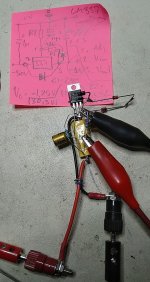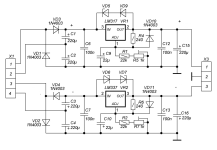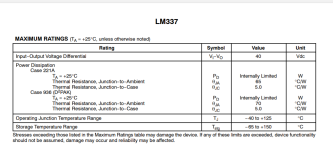The slope on those curves looks awfully steep, indicating a really low value of the equivalent of "plate resistance". How would you gainfully use such a thing?
Just for fun, here some measurements of it:Incredible good sound from this little design I created based on old schematics.
In fact, so good and sweet to listen!
PS.: I need to see on PCB the values missing in schematic.I calculated and tested when I stuffed the PCB

1W/8R load:
HD vs freq sweep:
Due to required and type of compensation used, the simple Miller, for stopping oscillations, is not possible to maintain same HD for HF vs the HD achieved in mid range.
For open loop designs using Ge, I already achieved constant HD vs freq (using fast Ge like 1T910 or GT806).
I found in local some old, unused types of Ge transistors 🙂
2N1099
But without nut, mounting top plate and mica isulation...
.


2N1099
But without nut, mounting top plate and mica isulation...
.
I am thinking to use for some JLH concept with Ge parts?
Is ot posibile to use as end power units?
Advices?
Is ot posibile to use as end power units?
Advices?
quite possible, with some care
I'm tired, long day
So, not too much babbling , for change
Objective: make it before Pa, and (normally) make it more complicated than Pa
What: amp using Germanium Biguns
schm:
edit: while I was dreaming about and working on this amp, I was often thinking about Pa's Joe and Jack
friendship, love and appreciation are very important parts of life
edit on 24. April 2021: THD measurements with 1T813 ( USSR!) instead of 2N1099 , post #68 Old Soul
edit on 15.09.2021 - few general setting procedure tips and tricks; be sure to read to the very bottom of...
So, not too much babbling , for change

Objective: make it before Pa, and (normally) make it more complicated than Pa
What: amp using Germanium Biguns
schm:
edit: while I was dreaming about and working on this amp, I was often thinking about Pa's Joe and Jack
friendship, love and appreciation are very important parts of life
edit on 24. April 2021: THD measurements with 1T813 ( USSR!) instead of 2N1099 , post #68 Old Soul
edit on 15.09.2021 - few general setting procedure tips and tricks; be sure to read to the very bottom of...
Yes, I went trough a tread 🙂
Old soul concept also is good, reduced number of elements, tested, stabile etc...
Also a mix of Ge, Si and BJT, MOSFETs.
I would like one amp with complete Ge devices...
.
Can Mosfet be substirute for instance with IGBT power type? Maybe some discrete version @Lazy Cat style IGBT?

Old soul concept also is good, reduced number of elements, tested, stabile etc...
Also a mix of Ge, Si and BJT, MOSFETs.
I would like one amp with complete Ge devices...
.
Can Mosfet be substirute for instance with IGBT power type? Maybe some discrete version @Lazy Cat style IGBT?
What is the power supply value for Old Soul?
+ - 15V
?
I have also LU1014 power JFET Maybe i can use in cascode for "upper" device instead of MOSFET
+ - 15V
?
I have also LU1014 power JFET Maybe i can use in cascode for "upper" device instead of MOSFET
Here is one more germanium riaa which have also two p-ch jfet, all class A, so suitable for Pass Labs forum. I have only one channel prototype and no distortion measurements, but it sounds good. Maybe later more measurements. Also no LTspice files or PCB.
If someone wants to try this and have different Idss fet's so it is possible to change R2 to get around 4mA current through it.
These old Ge devices are very temperature sensitive and NTC resistor helps a little to stabilize current through output BJT. Something like this one :
https://www.partco.fi/en/electronic-components/passives/resistors/ntc_resistors/5305-ntc-ax-10k.html
I have used this with a standard LM317 power supply, but maybe some super-reg may sound better or even batteries. 27volts should be "close enough" which means 3* 9V batteries in series. This takes more than 15mA from power supply...
Merry Christmas 🎄

If someone wants to try this and have different Idss fet's so it is possible to change R2 to get around 4mA current through it.
These old Ge devices are very temperature sensitive and NTC resistor helps a little to stabilize current through output BJT. Something like this one :
https://www.partco.fi/en/electronic-components/passives/resistors/ntc_resistors/5305-ntc-ax-10k.html
I have used this with a standard LM317 power supply, but maybe some super-reg may sound better or even batteries. 27volts should be "close enough" which means 3* 9V batteries in series. This takes more than 15mA from power supply...
Merry Christmas 🎄
Here is power supply using LM337 negative reg. Standard datasheet example, only Cadj=C2 is bigger than 10uF, which should give lower noise. I have used 50 Volts DIY linear power supply, but for example 48V switching power should work as well and more than something between 33V to 35V is not necessary. Another way to do this could be discrete design using PNP ge transistors (look at message #115). These LM337 don't have exactly 1.25V ref voltage which means output voltage is'nt exact 30.00V but it's "close enough".
This is simple design and you can always use more parts, but this works well like it is.

This is simple design and you can always use more parts, but this works well like it is.
I remember that in the old paper reference books for LM317 and LM337 the maximum input voltage 40V was indicated.
After reading this old thread :
I added two 15V zeners in series instead of D1. Maybe more on safe side, at start when reg charges C2 and C3 voltage can be more than 40Volts.
I was really thinking about that, is it possible to use these devices at 50V input, but it seems to work. Datasheet could be more informative about these things.
Here is one more protype powered via 48V switching power supply.
This gives 36.6V out which is near limits.

In a power amp, it is usually a good idea to run the input and VAS stages at a higher voltage than the ouput stage and to regulate if possible.
Unfortunately, the standard 317/337 regulators are only protected for input voltages up to 37 V. As they float, you can run them at higher voltage but then even a 100 µF cap on the output may kill them on power on.
I have seen and tried other approaches but so far they were either too complex or did not work satisfactorily.
The LM317HV will work up to 47 V, which is only a little better. There is the TL783 that will work up to 125 V which is...
Unfortunately, the standard 317/337 regulators are only protected for input voltages up to 37 V. As they float, you can run them at higher voltage but then even a 100 µF cap on the output may kill them on power on.
I have seen and tried other approaches but so far they were either too complex or did not work satisfactorily.
The LM317HV will work up to 47 V, which is only a little better. There is the TL783 that will work up to 125 V which is...
- capslock
- Replies: 15
- Forum: Power Supplies
I added two 15V zeners in series instead of D1. Maybe more on safe side, at start when reg charges C2 and C3 voltage can be more than 40Volts.
I was really thinking about that, is it possible to use these devices at 50V input, but it seems to work. Datasheet could be more informative about these things.
Here is one more protype powered via 48V switching power supply.
This gives 36.6V out which is near limits.

With zener diode, you can get much more stabilized voltage. It is not necessary to install 2 zener diode, one is enough for the desired voltage.
In any case, the circuit is more reliable with zeneribron.
The scheme that I showed above stabilizes 130V.
It follows from datasheet to LM337 that the maximum voltage between the entrance and the output of the microcircuit should be no more than 40V. If the diode between the entrance and the exit is replaced with zener diode, for example with 36V, then LM337 can be used to stabilize higher stresses
In any case, the circuit is more reliable with zeneribron.
The scheme that I showed above stabilizes 130V.
It follows from datasheet to LM337 that the maximum voltage between the entrance and the output of the microcircuit should be no more than 40V. If the diode between the entrance and the exit is replaced with zener diode, for example with 36V, then LM337 can be used to stabilize higher stresses
Yes, thanks again. Have done also one discrete reg using Ge and Si transistors, more about this later. Maybe better sound with discretes.
I think you guys will enjoy this.
Oliver Ward (aka Oliver Germanium) was the president of Germanium Power Devices. He was featured in a series of ads in the early 1980s humorously extolling the virtues of germanium.
Among his quotes were:
"Elementary my dear Schottky"
"The more we study Rectification',' says Oliver O Ward, President GPD and sometimes known as the Professor of Germanium, "the more we see that Silicon is clearly the outdated technology. "
https://www.mikrocontroller.net/attachment/532565/OliverGermaniumWard.png
https://forum.allaboutcircuits.com/threads/nostalgia-for-old-people-ollie-g.145728
Ed

Oliver Ward (aka Oliver Germanium) was the president of Germanium Power Devices. He was featured in a series of ads in the early 1980s humorously extolling the virtues of germanium.
Among his quotes were:
"Elementary my dear Schottky"
"The more we study Rectification',' says Oliver O Ward, President GPD and sometimes known as the Professor of Germanium, "the more we see that Silicon is clearly the outdated technology. "
https://www.mikrocontroller.net/attachment/532565/OliverGermaniumWard.png
https://forum.allaboutcircuits.com/threads/nostalgia-for-old-people-ollie-g.145728
Ed
- Home
- Amplifiers
- Pass Labs
- Germanium investigations

